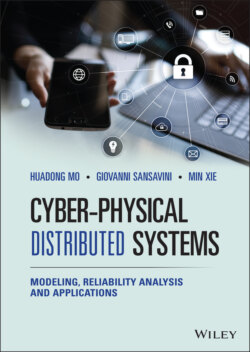Читать книгу Cyber-Physical Distributed Systems - Min Xie - Страница 15
1.2.2 Reliability of CPSs
ОглавлениеDistributed renewable energy sources are increasingly connected to power distribution networks as a remedy for environmental and economic concerns [110–112]. However, their power outputs are dependent on the available intermittent natural resources, such as solar irradiation, wind velocity, and biofuel production [113–115]. The rapid deployment and commercialization of storage devices and electric vehicles (EVs) has become an attractive technological solution to facilitate the use of renewable energy sources, manage demand loads, and decarbonize the residential sector [115–117]. The above technological issues call for managing real‐time energy imbalance in DGSs to meet electricity demand over a long‐term horizon. In order to address the challenges of distributed control of energy sources, communication networks are being installed for accurate control of the different power sources and the timely operational scheduling of distributed generator (DG) units, with the objective of providing reliable and sustainable energy in a timely fashion [118–123]. However, most existing research works do not formally investigate the capability of communication networks in providing real‐time power management and promoting the optimal power dispatch [124–127]. The effective integration of communication networks into DG systems is a key step in the realization of future smart grids [90,128].
Most integrated system‐of‐systems models have been developed based on dedicated and closed communication networks, where the infrastructure is exclusively built for smart grid applications [90,128,129]. As the network is dedicated between the DG and the control center, the data exchange is assumed to be perfect and free of defects (e.g., induced time delays and packet dropouts [130–134]). However, experience has shown that dedicated communication networks are ill‐suited to future DG systems, which require a different, more complex but much cheaper network, as its dimension would be much larger [135–137]. Because of the low installation cost, high transmission speed, and flexible access, the open communication network has the highest potential for integration with future DGSs [82,84,138]. As end‐users have to share the limited bandwidth in the open communication networks, which could lead to local congestion, they can be unreliable and suffer from network‐induced delays and packet dropouts [139–141].
Existing research works [42,123,139–146] do not model explicitly and adequately the behaviors of transmission delays and packet dropouts. Most of the aforementioned models are limited to constant or less stochastic transmission delays, which are not true in reality [147,148]. The delays are described by discrete‐time models or are neglected by assuming that they are much smaller than the communication interval [17,123,149,150]. Packet dropouts are usually modeled by a two‐state Markov chain and the associated quantitative loss rates; the detailed state evolution is masked and only input/output information is made available. The state transition matrix is known by assuming that the evolutions of packet dropouts can be fully observed [123,140]. Additionally, the models of uncertain renewable power sources do not consider time‐correlated properties [42,123,139,142,143,151]. Consequently, the control schemes derived based on such assumptions can be very conservative and may not be readily applicable to real systems.
To bridge this gap, a generic and transparent mathematical model is necessary for the analysis of the impacts of integration of unreliable open communication networks (e.g., home area networks, neighborhood area networks, and WANs). The major challenges lie in the modeling and simulation of the interactions between degraded communication networks and DG systems, and the optimization of the real‐time energy management problem on such system platforms. Note that the specific requirements (i.e., high‐frequency data and data prediction) introduced by communication network integration need to be taken into account in this modeling, simulation, and optimization framework.
